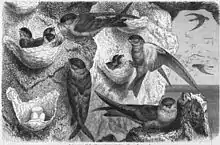Collocalia
Collocalia is a genus of swifts, containing some of the smaller species termed "swiftlets". Formerly a catch-all genus for these, a number of its former members are now normally (though not by all authors) placed in Aerodramus.
| Collocalia | |
|---|---|
 | |
| Glossy swiftlet (Collocalia esculenta) | |
| Scientific classification | |
| Kingdom: | Animalia |
| Phylum: | Chordata |
| Class: | Aves |
| Order: | Apodiformes |
| Family: | Apodidae |
| Tribe: | Collocaliini |
| Genus: | Collocalia G.R. Gray 1840 |
| Species | |
|
See text | |
The genus Collocalia was introduced by the English zoologist George Robert Gray in 1854.[1][2] The name Collocalia combines the classical Greek words kolla meaning "glue" and kalia for "nest".[3]
The genus previously contained fewer species. Seven subspecies of the glossy swiftlet were promoted to species status based on a detailed analysis of the swiftlets in the genus Collocalia published in 2017.[4][5]
Species
Extant
The genus now contains the following 11 species:[5]
- Plume-toed swiftlet, Collocalia affinis (formerly treated as a subspecies of the glossy swiftlet)
- Grey-rumped swiftlet, Collocalia marginata (formerly treated as a subspecies of the glossy swiftlet)
- Ridgetop swiftlet, Collocalia isonota (formerly treated as a subspecies of the glossy swiftlet)
- Tenggara swiftlet, Collocalia sumbawae (formerly treated as a subspecies of the glossy swiftlet)
- Drab swiftlet, Collocalia neglecta (formerly treated as a subspecies of the glossy swiftlet)
- Glossy swiftlet, Collocalia esculenta
- Satin swiftlet, Collocalia uropygialis (formerly treated as a subspecies of the glossy swiftlet)
- Bornean swiftlet, Collocalia dodgei
- Cave swiftlet, Collocalia linchi
- Christmas Island swiftlet, Collocalia natalis (formerly treated as a subspecies of the glossy swiftlet)
- Pygmy swiftlet, Collocalia troglodytes
Fossil species
An Early Miocene fossil swiftlet from the Riversleigh deposits of Australia was described as Collocalia buday.[6] This as well as a right ulna (MNZ S42799) found at the Bannockburn Formation of the Manuherikia Group near the Manuherikia River in Otago, New Zealand. Dating from the Early to Middle Miocene (Altonian, 19-16 million years ago),[7] probably belongs to Aerodramus.
References
- Peters, James Lee, ed. (1940). Check-list of Birds of the World. Volume 4. Cambridge, Massachusetts: Harvard University Press. p. 220.
- Gray, George Robert (1840). A List of the Genera of Birds : with an indication of the typical species of each genus. London: R. and J.E. Taylor. p. 8.
- Jobling, James A. (2010). The Helm Dictionary of Scientific Bird Names. London: Christopher Helm. p. 114. ISBN 978-1-4081-2501-4.
- Rheindt, Frank E.; Christidis, Les; Norman, Janette A.; Eaton, James A.; Sadanandan, Keren R.; Schodde, Richard (2017). "Speciation in Indo-Pacific swiftlets (Aves: Apodidae): integrating molecular and phenotypic data for a new provisional taxonomy of the Collocalia esculenta complex". Zootaxa. 4250 (5): 401–433. doi:10.11646/zootaxa.4250.5.1.
- Gill, Frank; Donsker, David, eds. (2017). "Owlet-nightjars, treeswifts & swifts". World Bird List Version 7.3. International Ornithologists' Union. Retrieved 18 August 2017.
- Boles, W.E. (2001). "A swiftlet (Apodidae: Collocaliini) from the Oligo-Miocene of Riversleigh, northwestern Queensland". Memoirs of the Association of Australasian Palaeontologists. 25: 45–52.
- Worthy et al. (2007)
Bibliography
- Worthy, Trevor H.; Tennyson, A.J.D.; Jones, C.; McNamara, J.A. & Douglas, B.J. (2007): Miocene waterfowl and other birds from central Otago, New Zealand. J. Syst. Palaeontol. 5(1): 1-39. doi:10.1017/S1477201906001957 (HTML abstract)